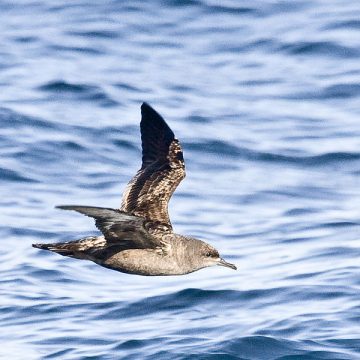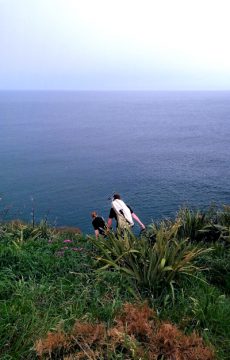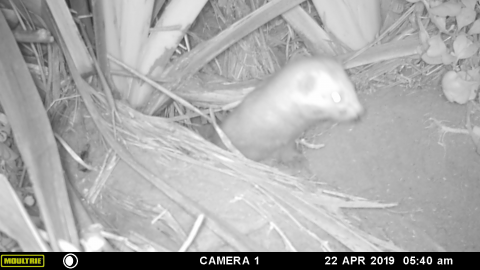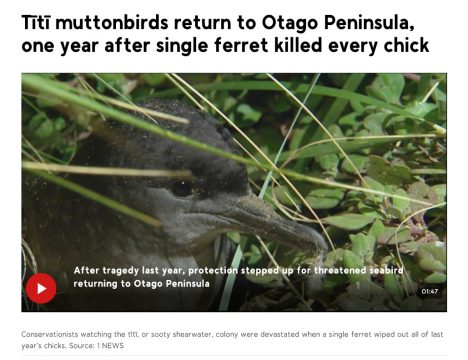An Uphill Climb

A sooty shearwater in flight. Source: wikimedia commons
By Ellen Ozarka (Forest & Bird coms intern)
“Where’s the track?” I thought to myself as we reached the end of the beach. My presumptive question was answered when I looked up to see Graeme scaling the grassy slope which appeared to loom over my head. There was no track, just a vague line of slightly trampled cocksfoot grass which covered the approximately 20 metre tall wall before me.
Heights are not my friend and neither is gravity, but everyone else in our group was so confident that I quickly forgot any trepidation or hesitation. Franny, the Dunedin projects manager, and her partner, Jorge, were even strapping their 3-year old son into a harness, so that Jorge could carry him up the steep hill. “Okay,” I thought, “if they can do this, I can. Let’s go.”
Our party of nine climbed up to Sandymount, the less experienced of us grasping at flax and grass for balance. The last time I had come face to face with grass this long was on a weeding mission where I’d cursed the plants’ strong and fibrous root systems. But now, hanging on for dear life, I was very grateful for it.

Over the cliff edge at Sandymount.
After about 15 minutes of climbing, I came face to face with a row of ice plant sporting delicate purple flowers. Stepping carefully over it, I suddenly found myself at the top of the ridge, looking out to sea, and waves crashing at the rocks below. If you were to travel due south from here, you wouldn’t reach land until Antarctica. And it was that direction that tītī, the objects of our search, would be returning from.
Tītī, also known as sooty shearwaters or muttonbirds, are cousins to the better-known albatrosses. Their annual migration is second only to the arctic tern, and they fly 64,000 km every year as they chase the sun. They enjoy the northern hemisphere summer in the Pacific waters off Korea, Japan, and California before returning to New Zealand (and some islands off the coast of Australia, Chile, and the Falklands) in November to clean out their nesting burrows. Once that’s done, they go off back to sea on a big fishing trip and don’t come back to land until December when they’re ready to breed.
As seabirds, tītī are among the most threatened birds in the world. It’s one of our biggest biodiversity crises, yet most people don’t know anything about it. Even the common red-billed gull/tarāpunga is better known for stealing chips at the beach, though it’s as in as much danger of extinction as kiwi.

Sunset at Sandymount.
Maybe the reason why we’re not aware about these threats is that most of them happen far from our sight. While seabirds are out at sea fishing, so is the commercial fishing industry, where seabirds are frequently caught as bycatch. If they manage to avoid that grisly fate, they still might succumb to plastic pollution, which fills their bellies instead of fish. Not that they can always find fish with climate change and overfishing making it increasingly harder and harder for them to find food. No wonder they go for your chips instead.
So you can imagine how anxious we were when waiting for the tītī to arrive this year. With other colonies reporting their shearwaters (of other species) not returning at all, and Sandymount still empty three weeks after tītī usually return, it was easy to imagine that they might never come back. Luckily, our fears were not confirmed and it turned out that this time they just were late.
Forest & Bird has been working at Sandymount for two years, and in that time no chicks have fledged from here. Tītī parents raise the chicks together, but then they bugger off about a month before the chicks are ready to fly. (When they do, they the chicks are able to find the way north all on their own.) But in that time period, they are incredibly vulnerable to predators, of which New Zealand has many. Earlier this year, wildlife tracking cameras at Sandymount dramatically revealed that one ferret made its way around the entire colony in a single night, killing the chicks at every monitored burrow.

In April 2019, one ferret killed all the remaining monitored chicks in one night.
That’s why we were here on the top of this cliff, with a cameraman and his heavy gear in tow. While we waited for nightfall and for the tītī to fly in from their daily feed, Graeme and Franny were interviewed for a news story we hoped would raise awareness of the plight of the tītī.
We briefly explored the top of the cliffs until Sue called out “Is anyone squeamish about cliffs?” I’m not too proud to admit that I stayed up at the top while the others disappeared over the edge to inspect some burrows and do some more filming.
It was a calm evening. The ocean stretched out before me and turned into horizon. It’s baffling how flat it can be. Down at Sandfly bay, distant sea lions, lazily settled in for the evening. An unusually red sun painted a striking sunset across the sky. Every now and then, a black-backed gull would soar out towards the horizon, proud and majestic, perfectly in its element.

Tv news went the extra mile to trek out to the breeding colony for footage of the birds.
Somewhere out there were the tītī we were hoping to film that night. I hoped that they would make it back tonight and every other night. And I hoped that, against all odds, their future chicks would survive this time and someday come home to Sandymount to have chicks of their own. Because like most seabirds, tītī certainly face an uphill climb.
